Museums and libraries! Just what we needed after Mexico! It is so wonderful to come back to the same place we stayed in London when we were last here (see my blogs for September 2015). Our friends’ lovely city apartment near Regents Park offers such a view of this place that we would never be able to experience if we had to pay for it. And just to remind us that we have still somehow angered the God of Construction: even here in plummy Marylebone, just as we did in Ajijic, Dubrovnik, and Vienna, we had a construction site right next door! Amusingly, the workers only made genteel, politely British bangs throughout the day.
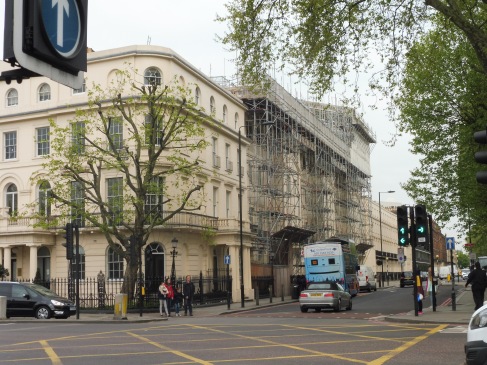
Our apartment was just on the other side of the scaffolding, which we could see from the front window.
Our first visit was to the Tate Britain, where we had heard of a rather controversial exhibition, “Queer British Art, 1861-1967,” and which I promised several gay friends I would report upon. (The David Hockney exhibition was also there, and was packed with visitors; he is immensely popular in Britain. His drawings are very nice, and I liked his video of the countryside, but his paintings: meh….too much familiarity perhaps?) The dates of the show commemorate two startling moments in gay history: in 1861, the death penalty was abolished as a punishment for sodomy, and 1967 saw the partial decriminalization of male homosexual acts. As the exhibition’s brochure explains, the term “queer” was chosen to emphasize the broad continuum of sexuality represented in the artworks on display.
If ever an exhibition required contextual labels, this one stands out. Indeed, many reviewers complained that the show had more to do with anecdotes about artists, innuendos about gay lifestyles, than it had to do with any particular aesthetic direction or quality. I found the show fascinating because of these revelations, and applaud its non-polemical approach to a complicated subject that opens up myriad possibilities for debate. I am in awe of the curators, who must have had many an obstreperous battle, first to identify their objects and to place them into a meaningful context. Can one really speak of a gay aesthetic? Why was it considered scandalous for women to paint images of nude women? Can one talk of “gay” content if one doesn’t know the artist’s intentions or sexual leanings? What role does class play in the long and tangled saga of persecution for homosexuality?
The Victorian room, labelled “Coded Desires”, was just bursting with “reading between the lines” repression and longing. Some of the stories, such as that of Simeon Solomon, Jewish and gay and eventually shunned despite his obvious artistic talents, were sad beyond imagining. Others offered hilarious examples of subversion, such as Joe Orton and Ken Halliwell’s altering of library books’ covers and blurbs with suggestive titles and images. And so many mergings of sexual identity! My favorite was the story of the “life partners” Edith Cooper and her niece Katherine Harris Bradley who combined themselves into one identity called Michael Field, a name under which they wrote many plays and poetry. I managed to take photos in the exhibit until the point where I was advised that photos were forbidden, so I wasn’t able to get many of the later images in the show.
But I had to go back to sneak one last picture of the most moving object: the door to the cell in which Oscar Wilde was incarcerated at Reading Gaol for his liaison with Lord Alfred Douglas. An entire section of the show focusses on Wilde’s case. Talk about a concrete example of the absurdity of trying to legislate morality and control sexual desires.
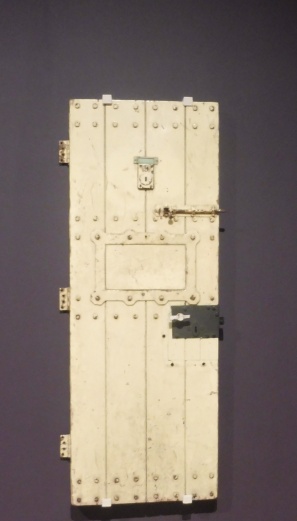
And now for something completely different: the Wellcome Collection, a thoroughly bustling place with an air of eccentricity turned to genuinely life-saving charitable ends. Sir Henry Wellcome, one of those 19th-century phenoms, the American self-made man, came to England and founded the pharmaceutical firm Wellcome and Burroughs (which would be the foundation of contemporary drug giant GlaxoSmithKline). Becoming immensely wealthy, he amassed an amazingly bizarre collection of objects, ostensibly relating to the history of medicine, and founded at the same time a medical library on the subject. My son tells me that the Wellcome Trust, the legacy of the man’s beneficence, is the single most significant medical charity in the world today, and is the organization that saved the human genome project from becoming a for-profit entity.
The building is a happy place, with temporary exhibitions, two bustling and very good restaurants, a permanent display including a minuscule number of Wellcome’s collected objects (including Florence Nightingale’s moccasins and Napoleon’s toothbrush!), a host of lectures, a great bookshop focussing on science and nature, and the magnificent Wellcome Library. George actually got a library membership card for free–our kind of place!
Through the generosity of our dear friend Ken, we also went to see the National Gallery’s show “Michelangelo and Sebastiano.” More Sebastiano than Michelangelo, but as with so many exhibits now (an approach that I personally enjoy), the show was really about context and milieu. The labels explain how Michelangelo took Sebastiano under his wing, out of his hatred for the wastrel Raphael, and as a way to thwart this younger artist’s ambitions. After the Queer Art show, I couldn’t help but read some gay subtext into all of this, but in any case, the artworks gained more immediacy once these stories were told.
Our final museum tour brought a hilarious surprise. The Royal Academy of Arts, housed in Burlington House–the last great 17th-century mansion in London–had as its exhibition…American Art of the 1930s! Organized by the Chicago Art Institute, it came from the Orangerie in Paris.
We laughed and laughed, to see Grant Wood’s “American Gothic” in the halls of the Royal Academy. Once again, I took a few surreptitious photos until I was caught.
We spent a lovely if nippy afternoon in Regents Park, admiring the gorgeous displays of spring flowers, so elegantly considered–curated by gardeners as any exhibition of art would be–with rows of tulips and other spring blossoms displayed in matching colors along each path. We were struck by two observations in the park: because the sun was out, despite what we considered rather chilly air, the natives were taking off their shoes and their jackets, lying in the sun to soak it up. We also noticed that the enormous crowds contained every nationality of the old British Empire. We heard at least 10 languages, most of which we didn’t recognize. Lots of “mixed” families, with beautiful children sporting completely British accents. London is nothing if not diverse. I couldn’t believe how many women in full purdah were shopping at Marks and Spencers and Selfridge.
This diversity was not in evidence in our final adventure, and was all the more striking for it. My favorite shoes are Hotter, a British mail order–and now online–company. I assumed when I got to London I would be able to find the shoes in regular shops in the city. Not so: the only shops that carry them are in the outer suburbs. In need of some attractive comfortable pairs, we ventured out on the Tube to Enfield Town, about an hour away. (I have just been informed that I am incorrect in my assertions about Enfield Town. Sorry! It does feel quite different from central London nonetheless.)
While appearing fairly prosperous, this was definitely Brexit territory. Not a brown face to be seen, or very few at least. These are the English who resent the EU, who fear immigrants, and feel that they have been ignored by the governments. All very congenial people nonetheless, which I must say has been the happiest aspect of this visit. People here seem to be comfortable in themselves and with their lot, are friendly and approachable. We felt little tension or aggravation anywhere, a welcome change from the charged atmosphere of the US right now. I’m sure that this observation is a very shallow one, but daily interactions and mundane observations do tell some of the story.
If only Britain had better weather!


























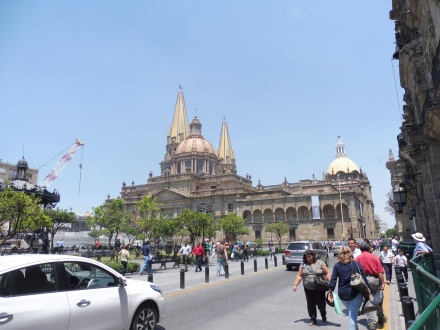

































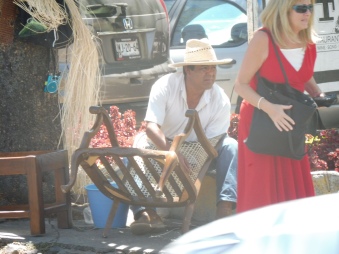





























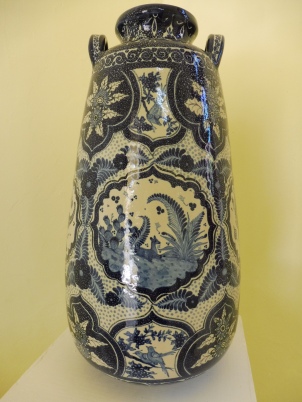
 Our next stop was the Museo Regional de la Ceramica, on Independencia, Tlaquepaque’s main shopping street. The setting is once again an impressive adobe complex, which was once a
Our next stop was the Museo Regional de la Ceramica, on Independencia, Tlaquepaque’s main shopping street. The setting is once again an impressive adobe complex, which was once a











